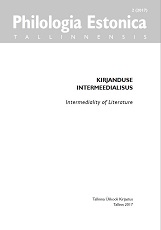Füüsiline teater: mõistest ja kujunemisest VAT Teatri lavastuse „Eine murul” näitel
About the concept and development of physical theatre. On the example of VAT Theatre production “The luncheon on the grass”
Author(s): Madli Pesti Subject(s): Language studies, Theatre, Dance, Performing Arts, Estonian Literature, Finno-Ugrian studies, Philology
Published by: Tallinna Ülikooli Kirjastus
Keywords: contemporary theatre;from animation to performance;theatre terminology in Estonian;
Summary/Abstract: One of the aims of the article is to define physical theatre. Physical theatre belongs to the performing arts, where physical expression dominates over other means of expression. The impulse to create a physical theatre performance comes from an idea or theme that the director and the performers want to express first and foremost physically. During the creative process several other means of expressions can be used in addition to the physical. Physical theatre is a formal concept, not a semantic one. The performers can express adiversity of content through physical means.Physical theatre often uses devised methods and improvisation.The performers display an intensive presence and energy on stage.The term physical theatre was first introduced by Lloyd Newson,who created DV8 Physical Theatre in 1986. The article sketches the four paths of development of physical theatre: the tradition of corporeal mime and pantomime, the tradition of different forms of dance, the tradition set out by avant-garde and performance art, and the tradition of physicalizing narrative.The development of physical theatre in Estonia is not very widespread. Out of the four traditions, three are present in Estonia: those of dance (Renate Keerd), narrative (VAT Theatre) and corporeal mime(Moon Productions). Th e article takes a closer look at the physical theatre production “The Luncheon on the Grass”, a physical narrative based production by VAT Theatre (director Tanel Saar, 2017). Physical theatre is an umbrella term that does not have a clearly defined set of creative methods or aesthetics. The usefulness of the term for theatre research lies in the fact that the term allows focus. If a performance is determined to be an example of physical theatre,our attention can be directed to physical expression, the presence and energy of the performer, and the visual and material qualities of the performance.
Journal: Philologia Estonica Tallinnensis
- Issue Year: 2/2017
- Issue No: 1
- Page Range: 59-84
- Page Count: 26
- Language: Estonian

